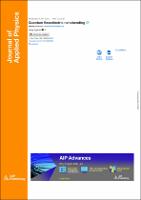Please use this identifier to cite or link to this item:
https://hdl.handle.net/20.500.12202/9432| Title: | Quantum flexoelectric nanobending |
| Authors: | Zypman, Fredy 0000-0002-2033-3772 |
| Keywords: | Electronic band structure Piezoelectricity Electrical properties and parameters Dielectric materials Atomic force microscopy Nanotechnology application Nanotubes Schrodinger equations |
| Issue Date: | 20-May-2021 |
| Publisher: | American Institute of Physics |
| Citation: | Zypman, F. (2021). Quantum flexoelectric nanobending. Journal of Applied Physics, 129(194305). https://doi.org/10.1063/5.0048724 |
| Series/Report no.: | Journal of Applied Physics; |
| Abstract: | The aim of this article is twofold. First, to develop a clear quantum theoretical playground where questions about the connection between strain fields and electric fields could be unambiguously explored. Second, as an application, to derive a criterion that establishes the length scale below which bent molecules, in particular, carbon nanotubes, display flexoelectricty. To this end, we consider a model molecule that displays the basic elements necessary to support flexoelectricity. Due to its simplicity, a full quantum mechanical solution is possible, providing analytical expressions for the energy bands and for the electronic states and their corresponding strain gradient-induced charge density. This charge density is in turn used to evaluate the appearance of electric fields. Finally, we investigate the consequences of applying our model to real organic ring systems, in particular, answering the question of whether flexoelectricity found in the theory should be present in experiments. |
| Description: | Scholarly article / Open access |
| URI: | https://hdl.handle.net/20.500.12202/9432 |
| ISSN: | 0021-8979 |
| Appears in Collections: | Yeshiva College: Faculty Publications |
Files in This Item:
| File | Description | Size | Format | |
|---|---|---|---|---|
| Zypman 2021 OA Quantum 194305_1_online.pdf | 915.46 kB | Adobe PDF |  View/Open |
This item is licensed under a Creative Commons License

